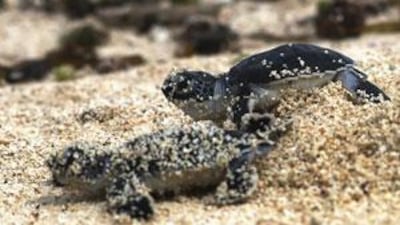The Abu Dhabi Government is reviewing a law that would more than quadruple the size of the Al Yasat Marine Protected Area, pushing its boundaries into the Arabian Gulf. The preserve, measuring 428 square kilometres, includes four islands and their surrounding waters. Rare marine creatures, including sea turtles and the dugong - which is endangered - live, breed and forage there.
The move would both foster more biodiversity and improve the UAE's environmental reputation worldwide, officials said. "The declaration has come at the right time," said Dr Thabit Zahran al Abdessalaam, director of marine biodiversity management at the Environment Agency - Abu Dhabi (EAD). "Some of the islands have been subject to changed land use and increased human activities that were affecting the nesting of turtles and the well-being of other animals."
The law, if enacted, will expand the area to 2,046 sq km, including seven more islands and several smaller islets, Dr al Abdessalaam said. That would make seven per cent of Abu Dhabi's wilderness protected; the agency hopes to increase that to 12 per cent by 2012. Most protected areas usually include a core zone that restricts public access, except for scientists and staff. More activities generally are allowed further from the zone, with many protected areas featuring controlled tourism. The EAD's plan is likely to set aside two core areas in the expanded reserve. Other zones may allow traditional fishing or other recreational activities, Dr al Abdessalaam said.
It is not known when Sheikh Khalifa bin Zayed, President of the UAE, will sign the law, but once it has been approved, the EAD will pursue international recognition for Al Yasat, Dr al Abdessalaam said. The agency has achieved international recognition for another protected area in Abu Dhabi, the Marawah Marine Biosphere Reserve, which is recognised by the United Nations Educational, Scientific and Cultural Organization (Unesco).
EAD wants Al Yasat to meet the criteria set out by Unesco or the International Union for the Conservation of Nature, officials said. "This improves our image in terms of environmental responsibility and provides more legitimacy for the area's protection," Dr al Abdessalaam said. In terms of biodiversity, one of the biggest beneficiaries could be dugongs, large but shy marine mammals who feed on sea grass. There are about 3,000 of the endangered creatures in the UAE, which has the second-largest population in the world. Twenty per cent of the country's dugongs live in the area around Al Yasat.
"We have noticed an increase in the number of dugongs in this area and we think this is because of the pressure they are getting in Bahrain and Qatar," Dr al Abdessalaam said. Besides being a home for dugongs, which find abundant sea grass in the area, the Al Yasat marine protected area is an important nesting and foraging ground for sea turtles. One of the islands has a population of desert rabbits, while the reefs around another island in the area have more than 18 species of hard coral.
There are important bird colonies as well, including flamingos, terns and the sooty falcon. One of the islands has a large breeding colony of Socotra cormorants, listed as vulnerable to extinction. The move comes as human activities encroach on the UAE's waters. The country's most important commercially viable fish species are overfished. Despite some signs of recovery in Abu Dhabi, hammour still are being driven into extinction.
In addition, the development of ports and harbours, industrial and oil and gas facilities and property is affecting coastal species. vtodorova@thenational.ae

